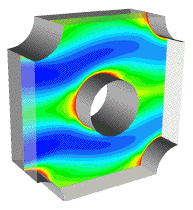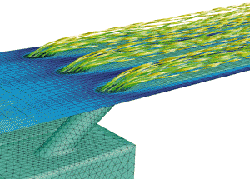Computational Methods of Heat Transfer (CHT) & Fluid Dynamics (CFD) |
||
| CFD Resources
ISoftware Packages
|
The use of computational Methods to solve engineering problems have experienced exponential growth in recent years due to the advent of high speed computers and easy-to-use software packages. Because of the increasing complexities of the modern technology, analytical solutions for many engineering applications are usually not available, while full scale experimental investigations are too expensive and time-consuming. Therefore, computational methods have played an important role in providing relatively quick and reliable solutions in these situations. The most common computational schemes are the finite difference method and the finite element method. They all involve the discretization (links to lecture notes) of the domain of interest into small elements. Within these small regions, the governing equations can be approximated locally by sets of simplified equations. For example, the partial differential equations in conduction heat transfer can be replaced by a system of algebraic equations. These equations can then be solved by different numerical schemes (links to lecture notes). In our class, we are going to focus on the finite difference method only. If you want to know a little bit more about Finite element method (FEM), you can go here (links to the ALGOR homepage). The following are a few practical applications calculated using computational heat and fluid dynamics methods.
Circuit Design Flow field and temperature distribution on a circuit board inside a Motorola handheld electronic device is simulated using computational techniques. (From Flotherm, Inc.-A comparision of Flotherm-calculated results with experimental dataA comparision of Flotherm-calculated results with experimental data)
Heat Exchanger Color-coded temperature distribution inside a fin-and-tube heat exchanger shows local heat accumulation and enhanced heat transfer. (From Fluent Inc.)
Film CoolingStreams of cold air are blown tangentially to protect turbine blades from hot exhaust gas exiting from the combustion chamber. The blowing forms a thin film to provide a buffer zone between the hot gas and the turbine blades. (From Fluent, Inc.) |
|


